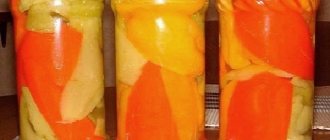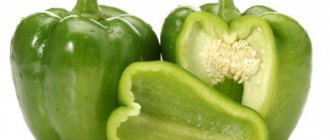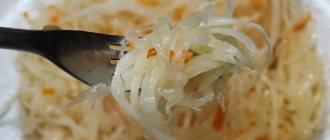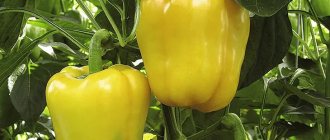Instructions
To try to remove the bitterness from bell peppers, you need to soak them in boiling water. After such processing, it will no longer be possible to use it fresh, but stuffing and boiling it will do the trick!
- Peel the pepper from grains and partitions.
- Rinse with cold water.
- Heat water to a boil and pour in pepper. It should lie in the water until it cools completely.
- Then drain the water and start cooking.
There are varieties in which the fruit itself is sweet, but the partitions and seeds are bitter. In this case, it is necessary to completely remove the partitions and rinse the pepper with cold water.
As a rule, unripe green peppers are bitter, while red and yellow ones grown without violations of technology are very rarely bitter.
What to do if the bitterness does not go away
If the pepper turns out to be so bitter that neither washing nor standing in boiling water can remove the bitterness, do not get upset and throw it in the trash.
Use pepper to prepare spicy adjika or hot sauces that include hot pepper in the recipe. You can cut the peppers into small slices and freeze them in small portions for seasonings, soups and borscht.
If you notice that pepper is bitter in a ready-made dish, you can mask the unpleasant taste by adding carrots or sugar. Make a sauce based on sour cream - it will hide the bitterness.
Tell me please! ? what needs to be done or added so that the stuffed peppers don’t taste bitter….
You need to throw the seeded pepper into boiling water for a few seconds, then drain the water - all the bitterness will come out and it will be easier to stuff the soft pepper (when it cools down)
Sprinkle the inside of the peeled pepper with lemon juice and leave for 20 minutes. Then stuff it.
don't take green peppers. take only red and yellow. Israeli ones are better - they never taste bitter.
If the pepper is bitter initially, then no methods will help. Lemon juice will not penetrate completely, and boiling will not destroy the bitterness either. Well, think for yourself, you already stew it (subject it to long-term heat treatment) already stuffed, but it still doesn’t go anywhere.
touch.otvet.mail.ru
Why is pepper bitter?
Sweet bell peppers become bitter if the technology for growing this vegetable is violated. Along with sweet peppers, bitter peppers were planted in between. During the flowering period, the pepper is cross-pollinated, and as a result the fruit acquires a specific bitter taste.
If you sow the seeds of such a hybrid pepper, the next year’s harvest will have a bitter taste uncharacteristic for the variety. Even the presence of single hot pepper bushes on a sweet plantation can ruin the entire harvest.
Therefore, it is necessary to strictly monitor the growing process and prevent cross-pollination with bitter varieties. You should also wait until the pepper is in a state of natural ripeness and do not pick unripe fruits.
The birthplace of bell pepper, oddly enough, is America, not Bulgaria. It was brought to Europe by conquistadors along with potatoes and tomatoes. “Bulgarian” varieties of sweet pepper are called only in the territory of the former USSR, because this country was famous for its cultivation due to its excellent warm climate.
Stuffed peppers are a delicious, hearty dish closely associated with summer. But the efforts of even experienced housewives to prepare this dish are not always crowned with success. It happens that stuffed peppers prepared according to all the rules are a little bitter. Why this happens and how to avoid it, we’ll try to figure it out in this article.
What can be made from green bell peppers for the winter. Is sweet pepper recommended for everyone?
Bell pepper strengthens the immune system, reduces the risk of developing cancer, has a positive effect on the entire cardiovascular system, and thins the blood. A bright vegetable normalizes the gastrointestinal tract, improves appetite, memory and vision. Nutritionists recommend including bell peppers in the menu of people suffering from diabetes and diseases of the skeletal system.
Sweet peppers are among the low-calorie vegetables. 100 g of fresh product contains only 25 kcal. This makes it possible not to limit its use to people who are obese and are actively struggling with extra centimeters at the waist.
The preparations are made, but is it worth eating sweet peppers in unlimited quantities? In case of certain disorders in the functioning of internal organs, the vitamin vegetable should be abandoned altogether or its amount in the diet should be minimized. These health problems include the following:
Unless you fall into one of the above categories, the unique properties of bell peppers can be enjoyed regardless of the season.
We tried to collect for you the most popular and useful recipes, preparations for this hero of our article. If you do not agree with these ratings, leave your rating in the comments with the reasoning for your choice. Thank you for your participation. Your opinion will be useful to other users.
- Thanks to this vegetable, you can replenish your diet with vitamins A, C, E, P, K, as well as B vitamins and valuable microelements (iodine, magnesium, zinc, potassium, phosphorus, iron, sodium).
What to do if stuffed peppers are bitter
The main reason for the spoiled taste is a violation of the cooking technology. Trying to save time, many people only clean the peppers from seeds and remove the stalk before stuffing. This is completely wrong. In 60% of cases, such pepper will taste bitter when cooked.
To avoid this, before starting to harvest the fruits, they must be prepared, namely, blanched for several minutes in well-salted water. This is done very simply:
- bring enough water to a boil;
- add a few teaspoons of salt;
- dip the peeled peppers in salted boiling water for 2 minutes;
- allow to drain and cool thoroughly;
- Stuff the peppers in the usual way.
If you plan to freeze stuffed peppers for future use, you need to process them in the same way, only dry them thoroughly before putting them in the freezer.
-Categories
- color families (16)
- malvaceae (3)
- bellflowers (2)
- violet (2)
- Euphorbiaceae (2)
- geranium (1)
- Lamiaceae (1)
- bluish (1)
- kennel (1)
- iris (1)
- primroses (1)
- hydrangea (1)
- ranunculaceae (1)
- Amaranthaceae (15)
- recipes (7)
- beets (8)
- Asteraceae (15)
- ageratum, marigolds (3)
- preparations, recipes (3)
- pyrethrum (2)
- calendula (2)
- chrysanthemum (2)
- asters (2)
- dandelion, artichoke (3)
- lettuce (3)
- chicory, endive (1)
- astronomy (24)
- biology (1)
- legumes (20)
- peas (8)
- recipes (1)
- blanks (4)
- beans (4)
- Grapes (4)
- knitting (50)
- cities, countries (25)
- dacha (689)
- inventory, tools (37)
- calendars, crop rotation, books (20)
- medicinal, green (32)
- fruits and berries, conifers (43)
- crafts, tips (42)
- buildings, repairs (56)
- soil (26)
- fertilizer (59)
- companies (58)
- flowers (109)
- what to cook (23)
- berries (38)
- children (35)
- Garden design (69)
- styles (17)
- pond (6)
- design elements (44)
- for diary, box (13)
- blanks (0)
- health (140)
- prevention (117)
- care (15)
- greens, herbs (7)
- blanks (5)
- cereals (16)
- preparations, recipes (6)
- cereals (3)
- corn (8)
- umbrella (35)
- recipes (5)
- blanks (5)
- carrots (17)
- parsley, dill (6)
- celery (3)
- Brassicas (56)
- white, red (19)
- recipes (14)
- cleome (1)
- broccoli, cauliflower (9)
- blanks (11)
- Beijing, Chinese, kohlrabi (3)
- radishes (8)
- radish, turnip (4)
- apartment (103)
- bathroom (7)
- children's (3)
- ideas (11)
- kitchen (6)
- clothes, shoes (5)
- repair (37)
- building materials (11)
- textiles (2)
- technology (6)
- cleaning (29)
- gooseberry (1)
- gooseberry (1)
- currant (1)
- cooking (454)
- sandwiches (12)
- baked goods (72)
- cereals, pasta (22)
- dairy, sour milk (14)
- meat (57)
- drinks (41)
- fillings, minced meat, cream (23)
- public catering. menu (73)
- first courses (60)
- post (10)
- dishes (7)
- seasonings (16)
- fish (30)
- salads, cold appetizers (77)
- tips, lessons (15)
- dough (19)
- decoration, serving (14)
- fruits, berries (4)
- bread, lavash (10)
- eggs, caviar (12)
- lilies (35)
- onion, garlic (25)
- recipes (4)
- Colchicum (1)
- lilies, daylilies (1)
- leek (5)
- chives, batun, multi-tiered (3)
- music (17)
- nightshades (133)
- eggplant, pepper (25)
- petunias (3)
- blanks (33)
- potatoes (35)
- recipes (21)
- tomatoes (41)
- fruit (6)
- blanks (6)
- seedlings (4)
- pink (21)
- roses (1)
- quince, chaenomeles (1)
- blanks (16)
- strawberries, blackberries, raspberries (2)
- apple, pear (1)
- Salad (1)
- crop rotation, plant compatibility (7)
- pumpkin (101)
- watermelons, melons (12)
- blanks (26)
- zucchini, squash (22)
- cucumbers (38)
- recipes (15)
- pumpkins (15)
- movies (46)
- country houses (16)
- miscellaneous (13)
- performances (7)
- feature films (10)
- chemistry (10)
- flower beds (30)
- work calendar (5)
- asteraceae (1)
- ornamental plants (7)
- circuits (17)
- quotes (61)
- sewing (93)
- machine embroidery (2)
- children (11)
- for women (36)
- for windows (4)
- fashion, styles (17)
- miscellaneous (28)
- repair (7)
-Music
-Search by diary
-Subscription by e-mail
-Regular readers
-Communities
-Statistics
Why are sweet peppers bitter?
They write that sweet and bitter pepper bushes should be planted at a distance of at least 5 m from each other, because they pollinate very successfully. It also happens that sweet and bitter peppers are cross-pollinated this year, and the peppers will have an unusual taste next season if you sow the collected seeds from cross-pollinated peppers.
It's all about the seeds. Either you planted seeds already cross-pollinated with hot pepper or you have this variety. There are now several varieties with mixed flavors on sale. The pepper itself is sweet, but the partitions are bitter. Try cutting off the partitions and taste whether the pepper itself is bitter or not.
Perhaps the seeds were stale, or the reason could be in the soil. Let’s say you added manure to the garden bed while digging, and there may also be an overdose of mineral fertilizers.
It was cold for a long time for the peppers, so unripe peppers taste bitter. Now it will be warm and dry and everything will go fine. With high humidity and coolness, little sugar is formed. Some varieties behave this way in bad weather. This will disappear in biological maturity. What is the shape of the pepper? If the fruits are narrow and long, then it may be really spicy.
Any peppers, whether red or green, must be poured with boiling water and left until the water cools completely, then drain the water and stuff it.
Pepper pollen is heavy and sticky. It is transferred to other varieties mainly by insects, sticking to their legs and abdomen. It is not even necessary to have hot pepper varieties in your garden or in your closest neighbors for the vegetable varieties to be pollinated with bitter ones. Even a distance of hundreds of meters from them will not save the landing from their influence. As you know, bees, for example, can fly up to 7 km from their hives and easily transfer a variety of pollen to other plants.
For those who are trying to get their own pepper seeds in our conditions, we can recommend isolating the flowers before opening the buds with cotton wool to prevent the ingress of foreign pollen.
You need to put the peppers in some container, for example, a wooden box, lining the bottom and walls with newspapers. And in each row put a green pepper, a ripe red pepper, or a ripe tomato, or a ripe apple, whatever you have on hand. Cover everything on top with newspaper too. If the peppers are collected at the stage of milky ripeness, they will ripen in a week. If they are technically ripe, then they should also (theoretically) ripen, but a little later.
The meaning of this procedure is that ripened vegetables and fruits emit ethylene gas, and under its influence green vegetables and fruits begin to ripen quickly. The main thing is that both of them lie together in one container, and the gas cannot diverge anywhere. If you wrap each one separately, then ethylene will not be able to spread throughout the entire volume and, on the contrary, the ripening of the peppers will slow down.
Anyone who watches Malysheva’s program knows that fruits and vegetables cannot be stored together with apples, apples affect everything, pushing them to overripe, so feel free to put apples in a container with pepper and it will turn red in an instant.
For many housewives in the summer, this dish becomes the basis of their diet, but the question of why stuffed peppers suddenly taste bitter is very relevant. By definition, rice and meat cannot taste bitter, so does it have to do with the casing? If this happens to you, be sure to find out why this happens in the future.
LiveInternetLiveInternet
-Music
—Categories
- display of goods (49)
- grocery (41)
- non-food (8)
- astronomy (36)
- knitting (42)
- cities, countries (33)
- dacha (1010)
- pests, beneficial (60)
- children (6)
- design, decor (84)
- inventory, tools (41)
- calendars, crop rotation, books (56)
- medicinal, green (32)
- vegetables (206)
- fruits and berries, conifers (42)
- crafts, tips (43)
- buildings, repairs (53)
- soil (15)
- fertilizer (56)
- companies (73)
- flowers (142)
- what to cook (32)
- berries (43)
- unusual (0)
- children (46)
- education (6)
- cartoons (12)
- training (16)
- school (1)
- for diary, box (40)
- blanks (70)
- adjikas, ketchups (9)
- jam, puree (6)
- freezing (8)
- pickling (23)
- pickling (31)
- salads, caviar (3)
- juices, drinks (4)
- drying (9)
- health (137)
- prevention (116)
- care (13)
- apartment (101)
- bathroom (7)
- children's (3)
- ideas (11)
- kitchen (7)
- clothes, shoes (5)
- repair (37)
- building materials (11)
- textiles (2)
- technology (6)
- cleaning (27)
- cooking (482)
- sandwiches (11)
- baked goods (72)
- for children (31)
- cereals, pasta (23)
- dairy, sour milk (14)
- meat (50)
- drinks (39)
- fillings, minced meat, cream (20)
- public catering. menu (79)
- vegetables (53)
- first courses (57)
- post (14)
- dishes (7)
- seasonings (14)
- fish (29)
- salads, cold appetizer (78)
- tips, lessons (13)
- dough (18)
- decoration, serving (12)
- fruits, berries (5)
- bread, lavash (10)
- eggs, caviar (12)
- music (24)
- unusual (78)
- news (70)
- useful tips. (0)
- holidays, religion (18)
- movies (122)
- history (25)
- history (82)
- feature films (17)
- chemistry (10)
- sewing (94)
- machine embroidery (2)
- children (11)
- for women (36)
- for windows (4)
- fashion, styles (18)
- miscellaneous (28)
- repair (7)
—Search by diary
—Subscription by e-mail
— Regular readers
—Communities
-Statistics
Why do stuffed peppers taste bitter after cooking?
There are many varieties of sweet peppers; they are excellent for preservation and can withstand freezing well. But it happens that the prepared dish begins to taste bitter. So what is the reason?
The dish is burnt
If you add little sauce when cooking peppers with minced meat, then it will most likely burn at the very bottom. To prevent this from happening, always place a couple of cabbage leaves on the bottom of the dish, and make sure there is enough sauce while cooking.
Wrong kind of pepper
It happens that the planted pepper sprouted from dusty seeds, then the fruits will look juicy and beautiful, but it will be impossible to eat them. Or is it its bitter relative, which is very similar to a sweet pepper. Always taste the pepper before cooking!
Improper preparation of vegetables
One of the reasons why stuffed peppers taste bitter is that the peppers are not properly prepared before stuffing. Pour boiling water over it after cleaning to remove excess bitterness and make it softer.
Unsuitable spices
We love adding various spices to our favorite dishes, but the fact is that not all of them go well with rice and vegetables. Limit yourself to salt and herbs for flavor, but allspice, garlic and an abundance of onions can give an unpleasant bitter taste when combined.
Secrets of making classic stuffed peppers
Vera Makarova
Stuffed peppers are bright, appetizing, with juicy meat filling, rice or vegetables. Everyone loves this light but satisfying dish! How to prevent peppers from falling apart during cooking? Why does the meat filling fall out? What can I do to prevent the rice from being hard? How do sweet peppers turn bitter and how to avoid it?
The answers to all these questions are in today's recipe.
Useful tips
- To stuff peppers, rice must be boiled until half cooked.
- Fresh ground peppers near the stalk have a sweet and bitter smell.
- To get rid of bitterness, soak the peppers in cold water for 15 minutes.
Ingredients
- Ground green pepper - 5 pcs;
- Short grain rice - 150 g;
- homemade minced meat - 400 g;
- onion - 300 g;
- carrots - 200 g;
- vegetable oil - 50 g;
- parsley - 1 bunch;
- dill - 1 bunch;
- tomato paste - 200 g;
- meat broth - 800 ml;
- sour cream 25% - 200 g;
- black pepper - to taste;
- salt - to taste.
What to do if stuffed peppers are bitter
Don’t rush to throw the delicious food in the trash - you can still save your favorite dish!
If the stuffed peppers taste bitter because they are burnt, discard any burnt bits. Then put it in a separate saucepan and fill it with a sauce of water, tomato paste and sour cream at the rate of 1 tablespoon of each ingredient per 0.5 liter of water. Cover with a lid and simmer the finished dish for 20 minutes.
Carrots perfectly save and “draw out” the bitterness. Chop it coarsely, add it to the dish in the sauce and cook over low heat until cooked, then pull out the carrot pieces and discard them.
There are never too many kitchen tricks - every housewife must know how and how much to cook khinkali.
If you liked this post, please leave a comment or subscribe to the RSS feed.
To stuff peppers, you need to choose large, intact red and yellow peppers; the taste of the finished dish depends on this. You can, of course, use green peppers, but they turn out less tasty and appetizing.
They begin to prepare stuffed peppers, the recipe for which can be any, always the same. First, the peppers themselves are processed; they are cut in half or only the top cap is cut off. Then they take out all the partitions and entrails so that they do not become bitter and boil them a little in boiling water so that they become softer and the minced meat inside cooks evenly and quickly.
The rice for the filling should be boiled in advance for 10 minutes until half cooked, cool, and add salt and pepper to taste. These little culinary tricks will save your time and make the dish juicier and tastier.
There are many recipes for making stuffed peppers, but they can be divided into three large groups:
- Peppers stuffed with meat filling
- Pepper stuffed with vegetable filling
- Pepper stuffed with mushroom or cheese filling
You can prepare stuffed peppers quite simply, quickly and tasty, a recipe with meat filling.
In the process of preparing the filling, use 700 g per 1 kg of peppers. minced meat, 1 cup of boiled rice, finely chopped carrots and onions pre-sautéed in vegetable oil, 2 eggs and spices. Mix the filling thoroughly and fill the peppers tightly, but without heaping.
Place the stuffed peppers tightly in a saucepan, add water in which the peppers were previously boiled so that the water does not completely cover the peppers and cook for 30 minutes. Then put a piece of butter in each pepper, finely chopped fresh tomatoes on top and cook for another 5-10 minutes. Place the finished peppers on a plate, pour sour cream and herbs on top. The result is a very tender, soft and juicy dish, you will lick your fingers!
Instead of tomatoes, you can use tomato paste, and add 1 tbsp to the minced meat. l mayonnaise instead of eggs, chopped garlic. The taste will be completely different, so experiment and find your favorite recipe.
Another interesting way to cook stuffed peppers, the recipe of which can be modified to suit your taste and habits. First, lightly fry the cooked, seeded and washed peppers in a frying pan in vegetable oil. Then prepare the filling. To do this, mix 0.5 kg of minced meat, 3 tbsp. l dry rice, sauteed carrots and onions, add spices, and then gradually mix into the minced meat finely chopped 2 cloves of garlic, grated 2 tomatoes without skin, 1 tbsp. l tomato paste, herbs, ½ tsp. Sahara.
Fill the peppers tightly with the prepared minced meat and place in a saucepan or frying pan with a thick bottom. Pour sour cream sauce over everything, for the preparation of which you need to take 1.5 cups of water, 200 g. sour cream and 3 tbsp. l tomato paste. Mix all ingredients thoroughly, add salt and pepper. Cook for about 40 minutes over low heat. Then turn it off and let it brew for another 10 minutes. This will add piquancy and a specific aroma to the finished dish.
For lovers of meatless dishes, you can cook peppers stuffed with vegetables; the recipe can be changed and you can get different tastes even for such a simple dish.
Use grated potatoes, cabbage, eggplant, zucchini, and carrots as minced meat; use ready-made pearl barley porridge instead of rice; you can add mushrooms. Pre-bake the peppers themselves in the oven until soft for 15 minutes. Then fill with filling, sprinkle cheese on top and put in the oven for another 10 minutes.
A very beautiful, tasty and soft dish is obtained if you prepare stuffed peppers, the recipe for which includes eggplants in the form of minced meat. It would seem like a strange combination of pepper, tomato and eggplant, but they add a peculiar zest to the finished dish, which looks beautiful even on the holiday table.
For the dish you need 8 eggplants, 5 peeled tomatoes and 6 cloves of garlic, finely chopped and sautéed in vegetable oil for 20 minutes. Add salt, sugar, pepper, herbs and spices and mix thoroughly. Then prepare a sauce from 3 tomatoes, salt, sugar, bay leaf and spices, which must be simmered in a frying pan under the lid for 15 minutes. Place the stuffed peppers in a mold, pour in the sauce, cover with foil and bake in the oven until done.
For the holiday table, you can use sweet peppers, the recipes of which do not even include heat treatment. If you take several peppers of different colors, fill them with filling, crushed in a blender from grated cheese, butter, crushed garlic and herbs, put in the refrigerator for 2 hours, you can prepare a beautiful and healthy snack. Chilled peppers are perfectly cut into thick rings with a knife, laid out beautifully on a plate and sprinkled with fresh herbs on top.
The large fruits of beautiful red or yellow peppers are loved by many for their fleshy, sweet pulp. It is tasty both fresh and canned, but sometimes bitter notes appear in the fruits. It is especially unclear why bell peppers are bitter if there are no beds with a spicy relative in the neighborhood. Pronounced or in the form of an aftertaste, bitterness nullifies all the efforts of gardeners and significantly spoils the harvest.
Capsicum
This is what botanists call all the beautiful multi-colored fruits that are familiar to us - red, green, yellow, orange, almost white. The shape of the fruit varies from regular cone to spherical. The sizes also differ: the hottest pods are smaller than the fingernail, and the sweetest large peppers reach 20 cm. Their main difference is their spiciness. And therefore, all such peppers are fundamentally divided into two groups - sweet and hot. The latter are often simply called chili.
The heat of peppers is due to capsaicin. This very pungent substance is found in all capsicums, but its content ranges from 0.007 to 1.9%. You don’t feel it in sweet peppers due to the small amount. Capsaicin is used in medicine as part of patches and rubs for radiculitis and other myalgia. For this substance, the plant (and its fruits) was called pepper, although it belongs to the nightshade family - it is a relative of tomatoes, potatoes and eggplants.
There are many varieties of sweet peppers. In addition to the most famous Bulgarian pepper, you can also find Moldavian Gogoshar and the sweetest pepper Romiro. They are consumed fresh in salads, and are also used in many vegetable dishes and in a variety of preparations.
Hot peppers are used fresh, dried or ground. As you already know, ground red pepper is the pods of hot pepper (chili) crushed into dust, which have previously been dried, stripped of their stems and seeds. All hot peppers are used as seasonings for a variety of dishes, including chocolate. Now we are used to it being in slabs and sweet, but the Indians traditionally made it liquid and with spicy seasonings.
Alexey Bueverov, Doctor of Medical Sciences, Professor of the First Moscow Medical University named after. Sechenova, specialist in liver diseases:
Traditionally, pepper and other hot spices were prohibited not only for liver diseases, but also for almost all diseases of the digestive tract. But in recent years, after a number of studies, it has become clear that they are safe for the liver. True, there is an exception: it is better not to take them in case of cirrhosis, when there is already swelling. This is due to the fact that spicy food increases water consumption. Therefore, they are not recommended for any other edema. If you eat too much spicy food, you may experience irritation of the gastric mucosa or acute gastritis. But it will pass quickly. Spices also have nothing to do with chronic gastritis, as was previously thought. This disease usually develops due to a special bacterium, Helicobacter pylori, that lives in the stomach, and not from spicy and salty foods, as was previously believed.
Ingredients:
- Bell pepper - 4 pcs.
- Quail eggs - 8 pcs.
- Minced meat (pork, beef) - 400-500 g
- Onion - 1 pc.
- Basil - 1 bunch
- Breadcrumbs - 4-5 tbsp. l.
- Salt, ground black
- pepper - to taste
How to cook:
- Boil and peel quail eggs.
- Mix minced meat, crackers, finely chopped onion and basil. Pepper and salt the minced meat. Add 40-50 ml of water and stir.
- Cut off the tail of the peppers to form a lid. Remove seeds and membranes. Fill the peppers halfway with minced meat, add an egg in the middle and fill completely with minced meat. Cover the peppers with tail caps.
- Place the peppers in an oven preheated to 200˚C and bake for about 1 hour.
Composition of red pepper
Hot vegetables are used raw
, and
dried
. They are suitable for preparing first courses, pickles, sauces, salads and as a spicy ingredient. However, in any form, pepper has unique characteristics.
Vitamins
All the main components of hot pepper tone and heal the body. Just a little of this vegetable can compensate for the body’s deficiency in (composition 100 g):
- – 0.6 g;
- – 0.5 g;
- – 140 mg;
- – 14 mcg;
- – 0.1 mg;
- – 0.7 mg;
In addition, the vegetable contains the alkaloid capsaicin.
, it is this that imparts bitterness and is distinguished by antibacterial, warming and analgesic properties.
Minerals
Scientists have proven that the range of useful elements of the hot vegetable (and in addition to vitamins, pepper is also enriched) exceeds 40 components. So, pepper contains in sufficient quantities (concentration per 100 g of product):
- – 18.1 mg;
- – 0.44 mcg;
- – 25.1 mg;
- – 173-174 mcg;
- – 7-8 mg;
- – 40-50 mg;
- – 0.19 mcg;
- – 0.25-0.3 mg;
- – 320-341 mg;
- – 1.22 mg.
In addition, 100 g of spicy vegetable contains 0.33 g of acid.
Did you know?
In the Caribbean, peppers are considered a fruit and eaten whole.
when to clean. pepper in a film greenhouse in the Moscow region
We don’t harvest anything until the first light frost, or if we can track the weather, it’s right before it. In a film greenhouse it can withstand -5 (depending on its quality and height), and then it gets warmer and everything grows... When the cleaning is underway, we collect everything that is left - small peppers, eggplants, small green tomatoes, clean it all, cut it, add onions and boil with salt, sugar, vinegar, oil and roll up the last salad. It turns out very tasty
The large fruits of beautiful red or yellow peppers are loved by many for their fleshy, sweet pulp. It is tasty both fresh and canned, but sometimes bitter notes appear in the fruits. It is especially unclear why bell peppers are bitter if there are no beds with a spicy relative in the neighborhood. Pronounced or in the form of an aftertaste, bitterness nullifies all the efforts of gardeners and significantly spoils the harvest.
Pepper ripening stages
Considering harvesting pepper to be a simple matter, many people pick the fruits at the stage of incomplete ripeness. This affects the taste and further storage and preparation of vegetables. Agrotechnicians distinguish 2 types of maturity:
- Technical (cleaning). It occurs 40-45 days after the formation of the ovaries, when the pepper has not yet fully acquired its characteristic varietal properties, but is already suitable for consumption and processing.
- Biological (natural). It begins when the seeds ripen and the crop acquires a bright varietal shade.
20-30 days pass between biological and technical maturity. During this time, vegetables accumulate the maximum amount of nutrients and vitamins and are saturated with sugars and microelements.
Important! Fully ripened bell peppers have the best flavor and distinct aroma. Therefore, it is recommended to collect them in this phase.
The heat of hot pepper can be adjusted. A technically ripe crop still contains a small amount of pungent substance, so it is collected for preparing mild dishes and marinades. If you plan to store the harvested crop for a long time or process it into a powdered state, it must be picked from the bushes at the stage of full biological maturity.
Why bell peppers are bitter - possible reasons
So, the first thing that comes to mind is cross-pollination. Indeed, there are recommendations that there should be a distance of at least 5 - 7 m between sweet and bitter varieties. However, experienced gardeners have long noticed that this is not enough. The thing is that sweet sticky pollen settles on the paws of bees and insects, which can carry it far beyond the established distance.
Other reasons for changes in the taste of bell peppers may include:
- The soil is too acidic, which he doesn't like.
- Excess of fertilizers, especially organics, or too concentrated solution of mineral fertilizer.
- Cold weather prevents heat-loving peppers from ripening evenly.
- The fruits are picked early and are simply still green.
Do not forget that the sown seeds could already have been taken from a pollinated plant. And it doesn’t matter at all whether they are store-bought or collected from your own garden beds.
Bell pepper does not bloom: what to do?
Do not rush to plant seedlings in open ground. This should be done only after stable warm temperatures have been established and the soil has sufficiently warmed up. Lack of lighting is an important factor in disrupting plant development. To eliminate the cause, it is necessary to adjust the light supply and install additional lighting. If there is a lack of nutrients, use fertilizing with well-proven preparations - “Ovary” and “Bud”. If there is an excess of nitrogenous fertilizers, it is necessary to generously shed the soil with warm water several times in order to wash away the excess nitrogenous compounds. If the buds fall off due to diseases, then the plants must be treated with Zircon or Epin.
Why don't hot peppers bloom?
The reasons why hot peppers do not bloom are similar to the reasons why there are problems with the flowering of bell peppers. But hot pepper has one more feature - it is often grown as a potted crop in a home or apartment. At the same time, sometimes you can observe an amazing phenomenon - grown seedlings actively bloom in open soils and practically do not bloom in favorable indoor growing conditions. What could be the problem? There is no temperature difference, the pepper is planted in fertile soil, the plant is healthy, what is it missing? Light and humidity! This is why hot peppers do not bloom at home. In order for plants to bloom, it is necessary to create optimal conditions for them:
• avoid temperature changes and drafts; • ensure the humidity level is 65%; • adjust lighting and watering; • apply complex fertilizers
Having removed the obstacles and ensured that the pepper blooms, it is necessary to properly care for the plant in the future and apply some secrets shared by experienced gardeners.
Secrets to growing a good pepper harvest
After the planted seedlings have taken root in the open ground, it is necessary to pinch the top of the pepper. This technique will stop the growth of the main stem and give impetus to the development of side shoots, which will allow you to form a beautiful compact plant.
Regularly carry out pinching - leave no more than five paired shoots on the plant to form a healthy, abundant harvest.
Follow agricultural cultivation techniques - watering, loosening, mulching the soil, fertilizing, including “dry fertilizing” - with wood ash.
Important! Growing sweet and hot peppers must be done in beds that are significantly distant from each other. If this rule is not followed, the pepper may become cross-pollinated and lose its varietal characteristics.
Tip: as a preventive measure to prevent pepper diseases, create beds of coriander, basil, and onions next to it, and sow marigolds and nasturtiums around the perimeter. This will be a good protection for the crop from the main pest - aphids. Also, as a preventive measure and to protect plants from pests, infusions of garlic or onions, dandelion stems, dry mustard or red hot pepper are used. These organic solutions are safe for humans and plants and can be used at any stage of the growing season.
Video: why peppers don’t bloom
https://youtube.com/watch?v=jxgJnvyUrbY
We looked at the main problems associated with flowering in different types of peppers and hope that the information, recommendations and tips provided will help you cope with the problem and grow an excellent pepper harvest!
Share “Why peppers don’t bloom”
How to remove bitterness from peppers
Of course, if the whole point is cross-pollination, then in this case it is difficult to change anything. Some housewives advise pouring boiling water over the fruits before eating and leaving until the liquid cools completely. Perhaps this method will help remove at least some of the bitterness, so it’s worth a try.
If the cause is increased soil acidity, add dolomite flour to the area in the fall. When using mineral fertilizers, strictly follow the dosage, and from organic matter, use only humus, but not fresh manure. If the weather has not allowed the vegetables to fully ripen and they are still half-green, use a little trick. Collect the entire harvest and place it in boxes in layers, layered with ripe apples. Fruits will help the peppers “reach” and become sweet.
And finally, we cannot help but mention one more nuance. To collect seeds from a good varietal bell pepper and prevent it from cross-pollinating, simply “prevent” the bees from getting to the flowers. Cover the buds with ordinary medical cotton wool, and then insects will not be able to get inside.
Reasons why peppers don't turn red
Every summer resident dreams of collecting large, fleshy and bright fruits on his plot. However, why, having reached a large size, do the peppers never ripen? There may be several reasons.
Varietal features
One of the common mistakes of inexperienced gardeners is trying to grow a high-quality crop from seeds collected from store-bought vegetables . Beautiful and large fruits, which can be bought all year round in supermarkets, are imported from China, Turkey, Egypt or the southern regions of Russia. The climatic conditions of these regions are very different from the middle zone, where crops lack heat and sunlight. Therefore, these varieties either do not ripen completely or ripen several weeks later than more adapted ones.
Reference. Some species should not turn red or yellow. Depending on the varietal properties, the pepper can have a shade from light green to bright purple and even chocolate. On the package with seeds, the instructions indicate the ripening time and color of vegetables at the stage of biological ripeness.
Unfavourable conditions
Unsuitable growing conditions for pepper also affect its ripening and coloring:
- Temperature regime. When the thermometer drops to 12°C, the growth and development of pepper stops, and when it rises to 35°C, the bushes quickly dry out. The optimal range is from 18 to 30°C.
- Lack of lighting . Peppers require at least 12 hours of exposure to sunlight. Ripening and fruiting are also impaired when daylight hours are too long - more than 14 hours.
- Violation of irrigation technique. Cold, unsettled water is absolutely unsuitable for this culture.
- Thickened planting. Fruits on bushes blocking each other ripen poorly and do not turn red for a long time due to lack of nutrients.
The method of watering affects the development of bushes. Water should not get on the stems and leaves; it should be carefully poured right to the root. The soil should not be overly moist - this will lead to the development of fungus and bacterial diseases.
Agrotechnical errors
Beginner gardeners make mistakes even at the stage of planting seeds. They can be added to the soil when temperature fluctuations are not expected day and night . The weather should be consistently warm and the soil should warm up sufficiently.
The soil for peppers should be light, fertile and nutritious. The beds are fertilized with organic compounds and dolomite flour is added. This allows you to normalize acidity. Neutral or slightly acidic soil is suitable for timely ripening of vegetables.
One of the reasons why peppers do not ripen is incorrect fertilizing technique. The crop does not tolerate excess nitrogen: instead of bearing fruit, the green mass actively develops and the bush grows strongly. A lack of potassium has a negative effect on the plant, without which redness may not occur at all. This problem is common in areas with a high content of peat or sand.
Attention! Compositions containing nitrogen cannot be applied during fruiting and flowering of the crop.
Pepper needs calcium fertilization at any stage of ripening. Its deficiency is well compensated with the help of wood ash. At the moment of fruit formation, phosphorus is added, and calcium nitrate is added 2-3 times throughout the growing season, which prevents rotting.
A plant with too many ovaries also does not produce a good harvest. For this reason, the fruits do not have time to develop to large sizes and the desired color. Therefore, it is recommended to remove the first inflorescence at the branching point of the stems. Only one, the strongest bud is left in the internodes, otherwise, due to the growth of branches, the bush will not have enough strength to ripen.
Reference. A large number of ovaries on one bush (more than 25) slows down biological maturity, and the pepper grows small.
Mistakes when growing bell peppers - video
6 min to read
This spice is rarely used in the cuisine of the peoples of Russia, especially since not every housewife knows how to remove the spiciness of chili peppers from a dish.
Spicy lovers use it by adding it to first courses, main dishes of fish, meat and chicken. Fresh chili is used to add piquancy and spiciness in vegetable salads, in warm salads with meat and seafood. In Korean salads, which have become popular and beloved, they are mainly used in dry, chopped form. However, not everyone loves pepper for its characteristic sharp bitterness, which takes your breath away and causes an unbearable burning sensation on the tongue and mouth.
If you have overdone the use of chili in your food, you should not throw away the food, as there are different ways to eliminate the spiciness so that everyone at the table is satisfied with the taste of the prepared food.
Saving a dish from being too spicy
Of all the varieties of hot red pepper, the most commonly consumed is bitter. What gives it its pungency is a burning substance - capsaicin, which can make breathing difficult and cause tears. It is enough to drink at least a sip of milk to reduce or remove the effect of pepper in the mouth and esophagus. Milk does not always help in cooking, since the ingredients in dishes may not be compatible with it. But there are several ways you can reduce the effects of bitterness. Let's look at how to neutralize the spice.
First meal
Hot first ones are cooked with plenty of water. Seasonings are added at the last minute of cooking. Some strictly use measuring spoons and quantities according to the recipe, while others measure everything by eye, and, as a rule, overdo it not only with hot pepper, but also with salt.
Note! Usually in countries where chili pepper is included in the regular diet, it is served on the table along with salt so that anyone can measure out as much as they need for the soup. But situations are different.
- Already prepared “spicy” soup, borscht, pea soup or other first ones are saved from excessive spiciness by cooking a second portion of the dish, but without spices. You will get 1.5–2 times more soup, but not so spicy. Or, to correct the taste of the dish, add water - up to half the volume and a few ingredients, with the exception of spices. It all depends on the amount of pepper. The volume of the soup will increase without excess heat.
- Grains are added to vegetable hodgepodges: bulgur, chickpeas, lentils, semolina, beans, which will absorb excess pungency, but also salt.
- An ordinary apple, carrot or potato, peeled, takes away some of the heat from the boiling broth. They are best used when preparing vegetable soup. Boil for a while, without boiling, and remove from the pan.
- Sour cream or cream in a bowl of any soup reduces the effect of chili, neutralizes the pepper and adds a pleasant taste.
- A teaspoon of sugar with 1/2 teaspoon of vinegar 6% will help reduce the effect of the pepper.
- A teaspoon of table grape or apple cider vinegar is added to vegetable goulash and borscht so that bitterness does not become a hindrance.
- And this method only works if the chili was used from the very beginning for cooking broths. Remove the pan from the heat and set aside to let the spices and seasonings settle to the bottom. Carefully pour the contents into another pan, reserving the spice portion. Add water and continue cooking the soup. The sharpness will remain, but will not burn much.
Main courses: meat, fish, chicken
Hot second dishes made from meat products for frying and baking in the oven are usually salted and peppered first, so that the meat gives juice and is saturated with spices. It is therefore important to take a sample at the very beginning, although sampling the raw product is not always encouraged.
Advice! It is better to prepare marinades with spices in a separate bowl, measuring each portion of herbs, pepper and spices.
Peppered meat, fish products, and poultry are saved from heat depending on the situation:
- It is enough to rinse raw meat, fish, and poultry prepared for marinating with running water to wash off the spices, and re-prepare the mixture without chili.
- The finished baked or fried meat dish is sprinkled with sugar and sprinkled with apple or grape vinegar to highlight the taste of the dish and reduce the burning sensation. Lemon juice will also help.
- The heat of fried meat, fish and chicken can be removed by spreading sour cream, mayonnaise, or grated cheese on top. And then bake in the oven. Sprinkle the finished dish with a little lemon juice.
- During frying or cooking, the severity of the chili can be partially reduced with the help of 2 tbsp sauce. l. sour cream, cream, yogurt, diluted with broth or water. With this method, the gravy must be constantly stirred so that the dairy product does not curdle. Cut large pieces of meat into small portions.
- Ready-made fried or stewed meat, where all these tips will not work, can be diluted with a side dish of rice, buckwheat, pasta, blanched vegetables without seasonings and spices, fresh juicy vegetables: cucumbers, tomatoes. Add a lot of greens. You can mix it with a side dish and additionally prepare a sour cream-based sauce or tomato sauce, which perfectly reduces the spiciness.
- Acidic vegetable products can help neutralize the sting: pickled cucumbers, tomatoes, carrots. You can serve them with meat, decorating the dish, or place a separate plate with vegetables, inviting guests to eat the main dish with sourness. Lemon, lime juice, and a little table vinegar may help.
- Spicy salted fish with spices is washed to remove both the bitterness and the salt; it is best served on the table, sprinkled with lemon juice and olive oil with plenty of fresh herbs.
- Peppered chicken with rice is saved in the following way: select pieces of meat from the rice in a separate dish, simmer with vegetables, with tomatoes with added sugar, without spices, or fry separately in sour cream. And dilute the rice with cooked stew.
- Boiled rice goes well with vegetable stews and cabbage. Stewed potatoes are mixed with sour cream and baked in the oven, sprinkled with grated cheese.
Salads
For salads, fresh chili pepper pods are used, the heat of which depends on the variety, as well as ground pepper into powder. The following steps will help if you have overdone the seasoning:
- For a spicy fresh vegetable salad, just add the amount of other ingredients to reduce the burning sensation. And try to remove the pods from the salad.
- Any hard cheese, cut into strips or grated on a coarse grater, also helps. You can drizzle the salad with olive oil and vinegar to reduce the burning sensation.
- If the salad is Korean from sticks of carrots and potatoes, then again the proven method is to increase the amount of products.
- Mixed salads (Olivier, Russian), in addition to adding ingredients, season with sour cream. Season the vinaigrettes with olive oil.
- Depending on the recipe, you can add nuts, almonds, flax seeds, and sesame seeds. They give a piquant taste to the salad. Olive oil will reduce the severity.
Remember! One of the best ways to save it is to use sour cream and lemon juice for dressing.











